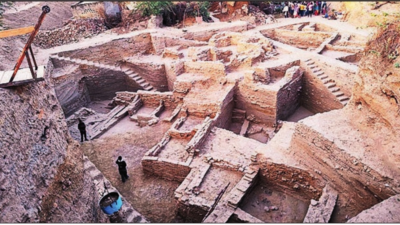Rajasthan dig reveals 3,500-year-old settlement: ASI traces ancient riverbed; findings may link it to Rig Veda-era Saraswati river | Jaipur News

JAIPUR: The Archaeological Survey of India (ASI) has dug up an ancient palaeochannel buried 23 metres under Bahaj village in Rajasthan’s Deeg district, leading a section of historians and archaeologists to link it to the mythical Saraswati river mentioned in the Rig Veda. The findings of the excavation, carried out between April 2024 and May this year, constitute evidence of settlements that thrived between 3500 and 1000 BC. Most of the discoveries date back to Kushan, Magadha and Sunga dynasties. Among the standout discoveries is the palaeochannel, the first such finding in Indian archaeological history. “This ancient river system nourished early human settlements and connects Bahaj to the larger Saraswati basin culture,” said Vinay Gupta, superintending archaeologist of ASI Jaipur, in a presentation at Banaras Hindu University (BHU). Gupta described the palaeochannel as an “unprecedented discovery confirming ancient water systems supported civilisation here”.Bahaj village is about 50km from Mathura. ASI has submitted a report to ministry of culture, which will decide how to preserve the site.Other findings include remnants of residential structures with earthen posts, trenches with stratified walls, furnaces and a variety of iron and copper artefacts. Microlithic tools or small stone implements suggest that the roots of this settlement date back to the pre-Holocene era.“The discovery of furnaces and metal objects indicates the inhabitants’ advanced knowledge of metallurgy,” Gupta said during an exhibition of antiquities in Deeg last month.The spiritual relics found by the excavation team include 15 yajna kundas (sacrificial pits), votive tanks dedicated to Shakti worship, and terracotta images of Shiva and Parvati, dating back to at least 1000 BC.Archaeologists also found four unbaked sealings, two inscribed with Brahmi letters. These are considered the earliest datable evidence of the Brahmi script on the subcontinent. Yajna kundas from the Mahajanapada period were also discovered, most of them filled with sandy soil and miniature pots holding uninscribed copper coins.Experts say this could challenge existing timelines on the origins of Indian coinage.The excavation also points to Bahaj’s rich craft heritage such as bone tool industries, semi-precious beads and shell bangle production. “The Bahaj excavation has the potential to rewrite key chapters of India’s early history,” Gupta said.





